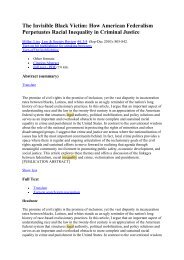Consumer Online Shopping Attitudes and Behavior: An ... - E-Journal
Consumer Online Shopping Attitudes and Behavior: An ... - E-Journal
Consumer Online Shopping Attitudes and Behavior: An ... - E-Journal
Create successful ePaper yourself
Turn your PDF publications into a flip-book with our unique Google optimized e-Paper software.
Electronic Commerce Customer Relationship Management<br />
Few of the 35 studies examined cover all ten factors, <strong>and</strong> there is some inconsistency in the empirical results of those that include<br />
similar factors. Nevertheless, for the sake of discussion, we integrate these ten factors in a model (Figure 1) in which the expected<br />
relationships among them are depicted. The five factors identified as antecedents are normally independent variables, although<br />
some studies have treated Website Quality as a dependent variable. These five factors directly determine attitude towards online<br />
shopping. Attitude <strong>and</strong> intention to shop online have been clearly identified <strong>and</strong> relatively widely studied in the existing empirical<br />
literature. Decision-making is the stage before consumers commit to online transaction or purchasing, <strong>and</strong> is sometimes considered<br />
to be a behavioral stage. The depicted relationships among attitude, intention, decision-making, <strong>and</strong> online purchasing are based<br />
on the theory of reasoned action (Fishbein <strong>and</strong> Ajzen 1975), which attempts to explain the relationship between beliefs, attitudes,<br />
intentions, <strong>and</strong> actual behavior. <strong>Consumer</strong> satisfaction is considered to be a separate factor in this study. It can occur at all possible<br />
stages depending on consumers’ involvement during the online shopping process. The relationships between satisfaction, attitude,<br />
intention, decision making <strong>and</strong> online purchasing are proposed to be two-way relationships due to the reciprocal influences of<br />
each on the other. In addition, two of the antecedents, vendor/service/product characteristics <strong>and</strong> Website quality, have been found<br />
to have direct impact on consumer satisfaction.<br />
<strong>An</strong>tecedents<br />
External<br />
Environment<br />
Demographics<br />
Personal<br />
Characteristics<br />
Vender/Service/<br />
Product<br />
Characteristics<br />
Website<br />
Quality<br />
Attitude<br />
towards<br />
<strong>Online</strong><br />
<strong>Shopping</strong><br />
510 2002 — Eighth Americas Conference on Information Systems<br />
Intention<br />
to Shop<br />
<strong>Online</strong><br />
Decision<br />
Making<br />
<strong>Consumer</strong> Satisfaction<br />
<strong>Online</strong><br />
Purchasing<br />
Figure 1. Research Model of <strong>Consumer</strong>s’ <strong>Online</strong> <strong>Shopping</strong> <strong>Attitudes</strong> <strong>and</strong> <strong>Behavior</strong><br />
Table 1 summarizes the distribution of factors among the studies indicating which factors have been the foci of attention in the<br />
empirical literature. Each of the factors <strong>and</strong> the empirical literature bearing on it is discussed in detail below.<br />
External Environment<br />
Only two out of 35 studies discuss the influence of external environment on online shopping. External environment refers to those<br />
contextual factors that impact consumers’ online shopping attitudes <strong>and</strong> behavior. It includes three dimensions. The first is the<br />
existing legal framework that protects the consumers from any kind of loss in online transactions. The second is the system of<br />
the Third Party Recognition in which many third party certification bodies are working to ensure the trustworthiness of online<br />
vendors (Borchers 2001). These two factors are positively associated with consumers’ trust attitude to the online stores. The third<br />
factor is the numbers of competitors, which can be defined as “the number of Internet stores that provide the same service <strong>and</strong><br />
products” (Lee et al. 2000, p.307). Lee <strong>and</strong> colleagues (2000) argue that the fewer the competing vendors, the greater the<br />
possibility of opportunistic behavior on the part of existing vendors so as to maximize profits. This increases transaction costs<br />
for the consumer, decreasing intention to revisit a specific online store.<br />
Demographics<br />
Eight of 35 studies examine the impact of demographics on online shopping attitudes <strong>and</strong> behavior. Demographics include such<br />
variables as age, gender, level of education, income, <strong>and</strong> time online. Bellman <strong>and</strong> colleagues (1999, p. 33) report that “Internet














